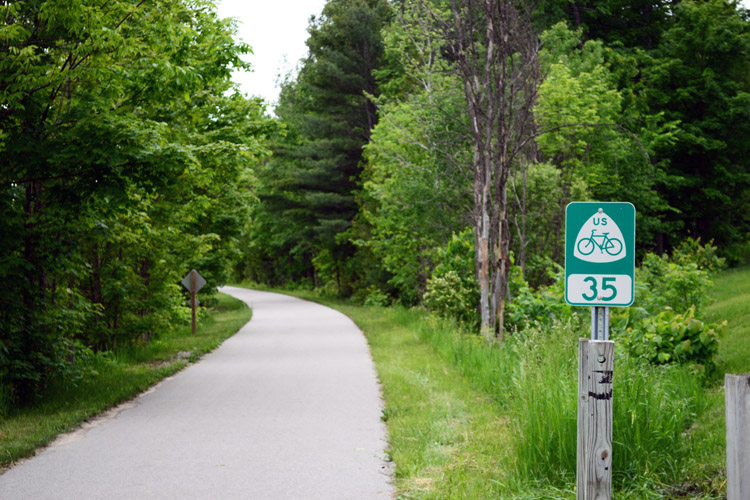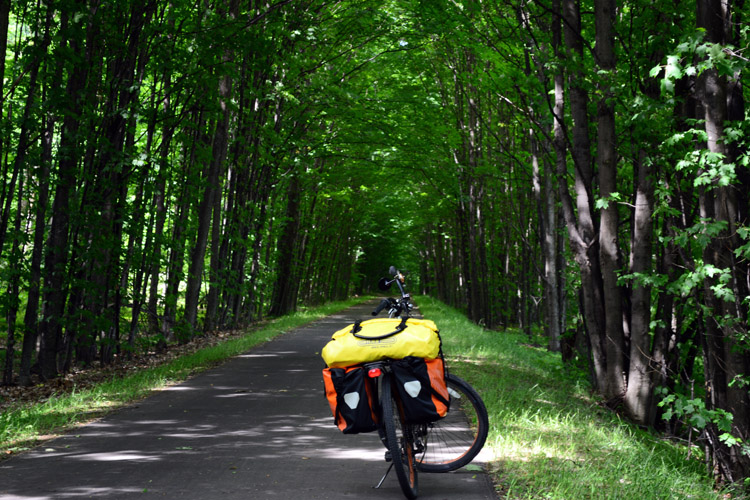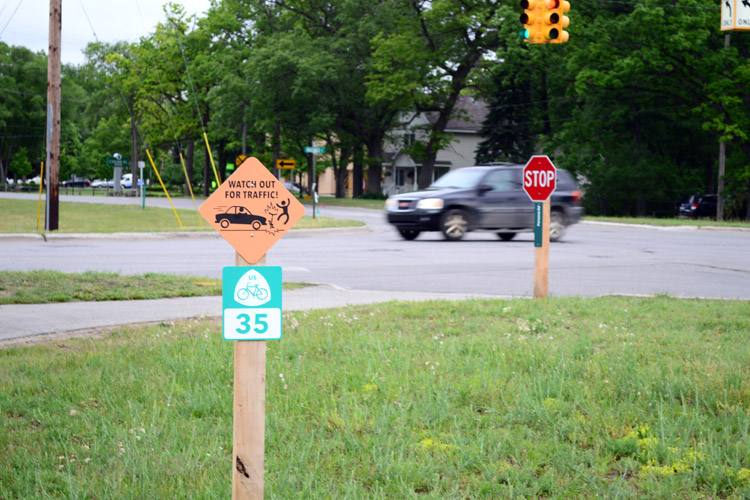Biking Michigan: Politics and safety
Mark Wedel |
Monday, August 15, 2016
I didn't tell my wife, but there were times when I felt like I could've been killed this June on my solo, 460-mile ride down the Lake Michigan coast, mostly on United States Bicycle Route 35.
She thinks I'm crazy for going on these rides (see part one of the story). Most of the time I disagree. But I wondered about my judgement while pedaling down US-31, in the vicinity of Torch Lake in Antrim County.
There, the highway becomes a narrow two-lane. Wide paved shoulders that give a bike lots of room become a skinny strip of pavement. Each time a vehicle, likely going 75 mph, approached in my rearview mirror, I faced a choice: Trust that they'll move over to avoid grazing me, or plow my bike, loaded with 35 lbs. of cargo, into the soft sandy, gravelly shoulder, risking a wipe-out.
When cars also approach from the front, giving the person coming from the rear no room to safely pass, the option is clear: Hit the dirt. I just sort of assume some drivers won't slow down and wait to pass at a safe distance when clear of oncoming traffic, as they are legally required.
The roads felt safer further south. But then, a couple days later, I heard that a driver killed five and seriously injured four riders in my hometown of Kalamazoo. This tragedy was a constant dark cloud over the rest of my ride.
Route Realities
 USBRs can vary from trails to busy highways.
USBRs can vary from trails to busy highways.
USBR 35 is a way to see, from a bicycle seat, the amazing spectrum of Michigan.
If only there were a way to pedal for days and not worry about traffic. If only your loved ones didn't feel they had to greet every phone call you make while on the road, as my wife does, by screaming, "YOU'RE ALIVE!"
"When you want to ride from the Indiana line to Sault Ste. Marie, there's no way you're going to find only rural quiet roads," USBR planner Kerry Irons says.
Quiet roads are the ideal routes for Adventure Cycling Association. The Montana-based bicycle touring advocates have been mapping routes for 40 years. As long as the route is reasonably safe and legal, they map it for touring cyclists.
Irons, an ACA volunteer on the USBR project since 2004, says, "We don't have to get permission to put a map together."
But the Michigan Department of Transportation (MDOT) does need permission from all parties to give official designations to USBRs. And when town governments, county road commissions and letters-to-the-editor writers get involved, political realities rule the routes.
Adventure Cycling has been working with states' DOTs to make the USBRs official.
The process has been slow. Michigan, with USBR 35, 20 and 10, is one of the leading states with officially-designated bike routes.
Irons has worked with around 70 road commissions and a bunch of DOTs to get official designations for USBRs. An avid bicyclist in Holland, he has a kindred spirit in Lansing, Josh DeBruyn, MDOT bicycle and pedestrian coordinator.
DeBruyn is a Kalamazoo native who can brag of pedaling over the Black Hills of South Dakota on a tandem with his wife and five-year-old son, "fully self-supported, with backpacks and panniers full of food, and a tent."
He's biked about 40 percent of the 500 miles of USBR 35, and field-reviewed the rest via motor vehicle.
The goal for the route, he says, was to make USBR 35 acceptable for experienced long-distance bikers. Trails should be paved, roads should have paved shoulders, and if there are no paved shoulders, traffic volume and speeds should be low. Scenic vistas and access to food, water and lodging are also pluses.
But compromises had to be made. "We needed the approval of all road agencies along the corridor," DeBruyn says. "MDOT did not impose on anybody the designation. They had to be willing customers, so to speak."
Local governments, county road commissions and other parties had to give "a resolution of support." Some refused, "so we had to seek secondary routes that might not have been our first choice. You probably found a couple of those," he says with a laugh.
Why, yes—US-31 in Antrim County. DeBruyn confirms that the planned route there would've taken bikers on quieter scenic roads along Torch and Elk Lakes.
The county rejected use of its roads for USBR 35, so US-31, under MDOT jurisdiction, was the only choice.
Irons goes into more detail: "The county had had some pedestrian issues, people walking on the road, cottage owners and interactions with cars ... at both Torch Lake and Elk Lake, and they said no."
Antrim's rejection of the USBR didn't ban bikes, however. As legal road vehicles, they can use the quieter roads—and they do. The Strava Global Heatmap, which analyzes GPS data from bikers, shows a bright line of riders traveling the choice roads along Torch Lake, and avoiding US-31.
Strava also shows heavy bike traffic on the immensely popular Tunnel of Trees scenic drive, M-119, in Emmet County.
 The writer's bike, during a break from long-distance cycling.
The writer's bike, during a break from long-distance cycling.
That very narrow road is usually full of tourists in slow-moving cars and motorcycles, in addition to bikes. But word got out in the local press that it was proposed as part of USBR 35. "Before we were able to get to the county to talk to them, the locals showed up with pitchforks," Irons says.
Since it's a state highway, MDOT could've placed the route there no matter what the county said. "But MDOT thought better of that, and I think probably appropriately," Irons says.
USBR 35 ended up taking a jagged route through the center of Emmet, ironically, on county roads.
"Those are the political realities of putting together a US Bike Route. What might be, from a bicyclist's perspective, the best route, doesn't always happen," Irons says.
Political and economic realities
Some communities are very welcoming to bicyclists rolling through, and some are outright hostile, Irons and DeBruyn have found.
"Bicyclists get in the way of cherry trucks," Leelanau County road commissions tell Irons.
Ottawa County commissioners say, "Well, we don't let people play basketball on the road."
Road commissioners, typically being focused on the practical, "just don't have the recreation mindset," Irons says.
But some communities are seeing the worth of sharing the road.
DeBruyn points to the 2014-15 MDOT study on the economic benefits of bicycling. Overall, Michigan's economy took in $668 million from biking in the years of the study. Bike-friendly cities like Grand Rapids saw $39.1 million of that, Holland saw $6.4 million, and Traverse City around $5 million.
Touring bicyclists spent an average of $520 per trip. "That's everyone from the person who camped and ate ramen noodles every day to the person who stayed in bed and breakfasts or hotels and ate at restaurants," DeBruyn says.
The study focused on Michigan bikers, he adds. "These are family members, friends, brothers, sisters, who are moving about the state and generating significant financial benefits to the state and local communities."
Responsible riding
The horrific collision in Kalamazoo made bicycle/traffic safety a vivid topic.
Before he moved to Lansing, DeBruyn rode with the Chain Gang, the group that was struck. He knew two of those killed, Tony Nelson and Larry Paulik.
Conditions on that road—"it was flat, it was open, there were paved shoulders"—plus the riders being experienced, and the driver seen being reckless before encountering the bicyclists, all show, "it was not a typical situation," he says.
If all bikers ride safely, and all roads have paved shoulders or bike lanes, then biking would be a significantly safer activity.
Also important, motorists need to remember they're controlling a potentially deadly machine.
"I agree that paved shoulders, bike lanes, pathways, are an excellent facility for bicyclists, but those can't be built everywhere," DeBruyn says.
"We really need drivers of motor vehicles to pay greater attention to all users of the roadway," he adds.
"Capital [for road improvements]
is limited, and bicycles are legal users of the roadway, so we all need to have the driver of the vehicle be more responsible, because they're the road user with the vehicle that can cause the greatest amount of harm."
Irons points out that the Kalamazoo deaths were "about two per cent of the national total for road rider deaths a year."
There are about 700 bike deaths a year on roads. "Half of them, roughly, are what you might call the 'urban ninja riders,' people with no lights, wrong side of the road, dark clothing at nighttime. A third to a quarter—because police don't keep very good statistics—the cyclist was DWI or DUI."
Out of the experienced and responsible road cyclists, "there's about 300 deaths a year." Irons adds he's biked for over 50 years and has never been hit.
He understands the fear of "3,000 pounds of metal" speeding past, but responsible biking is safer than people think, Irons says.
"Driving a passenger car has twice the fatality rate than riding a bicycle," he says, when looking at per hour usage. "It's eight times more dangerous to ride a motorcycle."
"Frankly, it's mostly down to the cars," Irons says.
Improved signage
 USBR 35 sign
USBR 35 sign
The good news is the section of US-31 that made me doubt my sanity is set for improvements, which include wider paved shoulders.
Also, more green-and-white USBR 35 signs are on the way. The signs are scattered along the 500-mile route, but are now only on roads under MDOT jurisdiction, and trails.
Adventure Cycling has raised nearly $15,000 in donations and grants to make signs for the rest. They should be delivered to local road agencies by the end of July, to be installed at their convenience. "I hope by this time next year, virtually all of the route will be signed," Irons says.
The signs help bikers find their way, but more importantly, they make drivers aware that bikes are using the road, DeBruyn says. He adds that MDOT is planning, for all roads, a new "yellow and black sign, that has a bicycle on it, with a plaque underneath it that says 'ON ROAD.'"
It's a more declarative message than the usual "Share the Road" bike sign. It tells drivers, "There will be bicyclists on the road, and you need to know they're there."
Mark Wedel is a freelance writer in Kalamazoo. He's about to finish his book, tentatively titled "Raw Power: Casually Obsessive and Obsessively Casual Long-Distance Biking." For more information, go here.